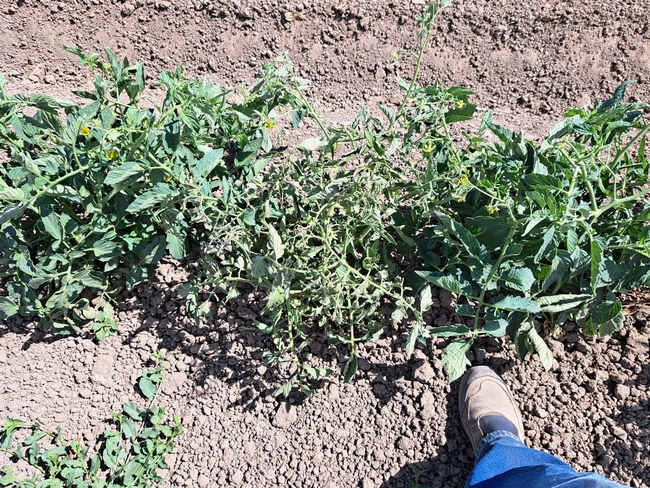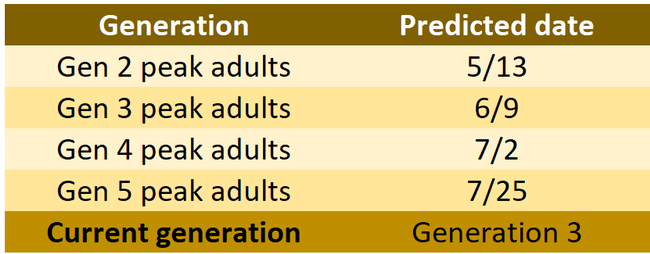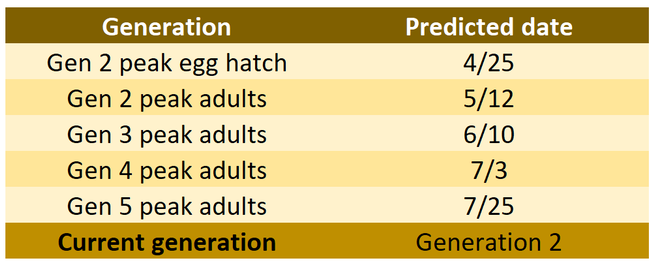- Author: Patricia Lazicki
- Author: Neil McRoberts
General situation
Almost all tomatoes are now in the ground. New TSWV infections will cause more yield loss in later than earlier plantings since the younger the plant is when it is infected, the more severe the disease will be. TSWV is only likely to reduce yields when infection occurs during or before fruit set.
Plant infected during early bloom exhibiting severe symptoms. This plant will likely die before it produces fruit.
Thrips population and outlook
We're currently at peak adults in generation 3. Those adults will be laying eggs, which means for the next few weeks generation 4 juveniles will be hatching and feeding. Generation 4 adults are set to peak on July 2nd. If you're seeing spread of TSWV in younger fields and are considering spraying, the next few weeks will be the most effective time to do it. 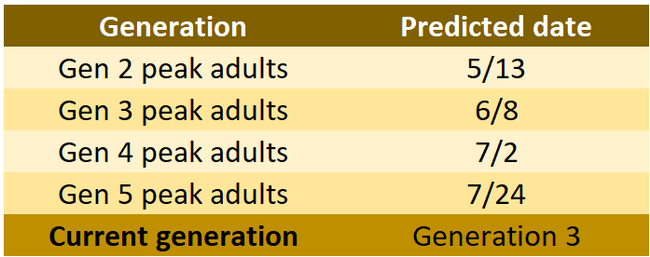
Professor Bob Gilbertson's virology team at UC Davis is working towards understanding the two new resistance-breaking strains of TSWV that are common in the Sacramento Valley. If you see plants with symptoms that look like TSWV, give me a call-- I'm interested in getting samples. We'd also like to understand if these strains are able to break resistance in peppers, so would like to get samples from symptomatic peppers as well.
- Author: Patricia Lazicki
- Author: Neil McRoberts
General situation
Temperatures over the past few weeks have been in the 80s and 90s, ideal conditions for thrips development. The hot weather coming up is also expected to accelerate thrips development and activity. I'm seeing some TSWV infection in nearly every field in Yolo and Solano counties that I visit, though generally at low (<1%) incidence.
Thrips population and outlook
We're in generation 3, with adults predicted to peak in the next week or so and generation 4 adults to peak in early July. Generations 3 and 4 represent the major risk of TSWV getting into crops before fruit set, so if you're planning to use insecticides to knock down thrips numbers, the next month or so is an important period. TSWV is only likely to reduce yields when infection occurs during or before fruit set, so all but very late-planted fields should be far enough along by Generation 5 (predicted to come towards the end of July) to shrug off any new strikes.
- Author: Patricia Lazicki
- Author: Neil McRoberts
General situation
Above-average temperatures this week compensate for below-average temperatures last week, and thrips population projections remain similar to earlier predictions.
Thrips population
Generation 2 adult thrips are peaking now, and will be laying their eggs. Thrips population will be predominantly Gen 3 nymphs through the second half of May. Again--for growers considering treatment, if the field is high risk (in an area that has been heavily affected in the past or you are seeing early infections) spraying in the next few weeks could be beneficial. Otherwise waiting until Gen 4 may pay off in terms of investment in thrips control.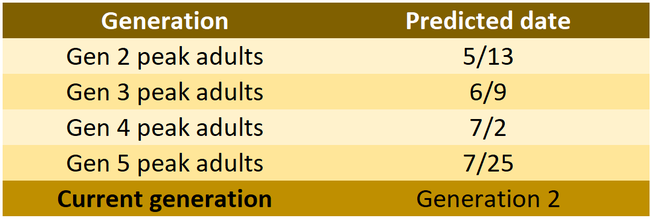
The resistance-breaking TSWV strain from Fresno has been detected in the northern counties since 2021, and last year another resistance-breaking strain was identified and appeared to be the dominant strain in Sutter and Colusa. I'm working with Bob Gilbertson's lab at UC Davis to understand more about the range and severity of these two strains. Feel free to contact me (530-219-5198; palazicki@ucdavis.edu) if you're seeing possible infections and would like confirmation.
Additionally, a reliable immunostrip test is available, which can be performed in the field to verify the presence of TSWV. The cost is $170 for a package of 25 test strips. https://orders.agdia.com/agdia-immunostrip-for-tswv-isk-39300
- Author: Patricia Lazicki
- Author: Neil McRoberts
General situation
Unseasonably cool weather has slowed thrips population projections slightly. However, temperatures may be into the 90s by the end of the week and we expect to see populations continue to develop.
Thrips population
Generation 2 adult thrips are peaking in the coming week. Thrips population will be predominantly nymphs through the second half of May. I've been seeing a few scattered infections in early-planted fields here in the north. There's a risk that when these Gen 3 nymphs become adults they will be able to spread the virus further. In historic hotspots, growers considering treatments should think about targeting these Gen 3 nymphs, especially if they are seeing any signs of the virus. Otherwise, generation 4 seems the more likely source for any significant chance for TSWV to spread around, and the more likely to pay off in terms of investment in thrips control.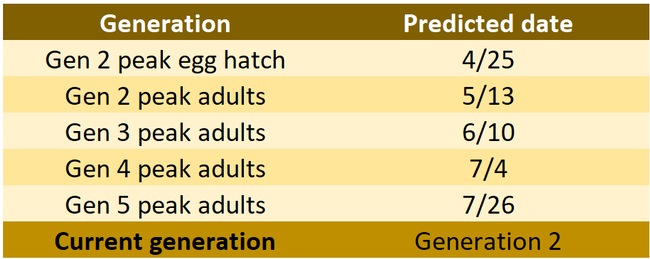
- Author: Patricia Lazicki
- Author: Neil McRoberts
General situation
Temperatures remain close to historic normals, and are predicted to remain moderate for the next few weeks. Planting is progressing throughout the Sacramento Valley. I've started to see some early TSWV infections in March-planted fields in Yolo County.
Thrips population
We're heading into the second generation of thrips; egg hatch peaked last week, and adults are predicted to peak May 12th (Fig. 1). 3rd generation adults are predicted to peak in early June, and 4th generation in early July.
In typical years like this is shaping up to be so far, our normal recommendation is that if you don't know of any local sources of TSWV and crops are not in the ground or are just planted it might be worth delaying any treatment until mid-June. It would allow generation 3 adults to breed and lay eggs, but will catch juveniles developing from generation 3 eggs and suppress the spread of any TSWV that has come into crops with generation 3 adults. If you do have local sources of TSWV, or if you've planted early and are worried about early entry of TSWV to your crop, consider treatments in weeks 2 or 3 of May to suppress generation 3 thrips, which could be carrying TSWV.
During this important period for thrips management decisions (Generations 2-4), I'll be posting weekly updates to this blog. Please feel free to contact me (palazicki@ucanr.edu, 530-219-5198) if you have any questions.

